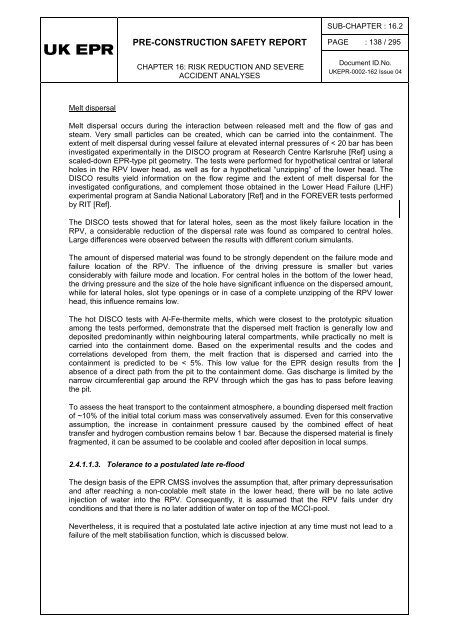16.2 - Severe Accident Analysis (RRC-B) - EDF Hinkley Point
16.2 - Severe Accident Analysis (RRC-B) - EDF Hinkley Point
16.2 - Severe Accident Analysis (RRC-B) - EDF Hinkley Point
You also want an ePaper? Increase the reach of your titles
YUMPU automatically turns print PDFs into web optimized ePapers that Google loves.
SUB-CHAPTER : <strong>16.2</strong>PRE-CONSTRUCTION SAFETY REPORTCHAPTER 16: RISK REDUCTION AND SEVEREACCIDENT ANALYSESPAGE : 138 / 295Document ID.No.UKEPR-0002-162 Issue 04Melt dispersalMelt dispersal occurs during the interaction between released melt and the flow of gas andsteam. Very small particles can be created, which can be carried into the containment. Theextent of melt dispersal during vessel failure at elevated internal pressures of < 20 bar has beeninvestigated experimentally in the DISCO program at Research Centre Karlsruhe [Ref] using ascaled-down EPR-type pit geometry. The tests were performed for hypothetical central or lateralholes in the RPV lower head, as well as for a hypothetical “unzipping” of the lower head. TheDISCO results yield information on the flow regime and the extent of melt dispersal for theinvestigated configurations, and complement those obtained in the Lower Head Failure (LHF)experimental program at Sandia National Laboratory [Ref] and in the FOREVER tests performedby RIT [Ref].The DISCO tests showed that for lateral holes, seen as the most likely failure location in theRPV, a considerable reduction of the dispersal rate was found as compared to central holes.Large differences were observed between the results with different corium simulants.The amount of dispersed material was found to be strongly dependent on the failure mode andfailure location of the RPV. The influence of the driving pressure is smaller but variesconsiderably with failure mode and location. For central holes in the bottom of the lower head,the driving pressure and the size of the hole have significant influence on the dispersed amount,while for lateral holes, slot type openings or in case of a complete unzipping of the RPV lowerhead, this influence remains low.The hot DISCO tests with Al-Fe-thermite melts, which were closest to the prototypic situationamong the tests performed, demonstrate that the dispersed melt fraction is generally low anddeposited predominantly within neighbouring lateral compartments, while practically no melt iscarried into the containment dome. Based on the experimental results and the codes andcorrelations developed from them, the melt fraction that is dispersed and carried into thecontainment is predicted to be < 5%. This low value for the EPR design results from theabsence of a direct path from the pit to the containment dome. Gas discharge is limited by thenarrow circumferential gap around the RPV through which the gas has to pass before leavingthe pit.To assess the heat transport to the containment atmosphere, a bounding dispersed melt fractionof ~10% of the initial total corium mass was conservatively assumed. Even for this conservativeassumption, the increase in containment pressure caused by the combined effect of heattransfer and hydrogen combustion remains below 1 bar. Because the dispersed material is finelyfragmented, it can be assumed to be coolable and cooled after deposition in local sumps.2.4.1.1.3. Tolerance to a postulated late re-floodThe design basis of the EPR CMSS involves the assumption that, after primary depressurisationand after reaching a non-coolable melt state in the lower head, there will be no late activeinjection of water into the RPV. Consequently, it is assumed that the RPV fails under dryconditions and that there is no later addition of water on top of the MCCI-pool.Nevertheless, it is required that a postulated late active injection at any time must not lead to afailure of the melt stabilisation function, which is discussed below.













![6.3 - Safety Injection System (RIS [SIS]) - EDF Hinkley Point](https://img.yumpu.com/42739985/1/184x260/63-safety-injection-system-ris-sis-edf-hinkley-point.jpg?quality=85)


